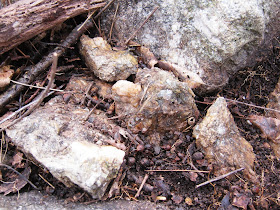Look for:
1.) Stones that resemble Turtles
1.) Stones that resemble Turtles
a. - Artistically added into Káhtôquwukansh
or “Stone Prayers” - those so-called "Field Clearing Heaps" or "Rock Piles" or "Stone Mounds" - as well as larger Turtle Effigies on boulders.
b. - incorporated into Qusukqaniyutôkansh - those rows of stacked stones known colloquially as "Stone Walls," misidentified more often than not as Yankee Farmer Walls.
c. - anywhere else that I can't think of at the moment.
Trying to decide about this one, in a never plowed "boulder field," was easy:
I did have to look at the other side:
I walked closer, looked down and saw a composite turtle - a carapace, head and forelegs with a plastron below - artistically stacked into the mound.
It's especially true if there are more turtle-like stones placed on nearby boulders - or even a single stone that resembles a turtle like this one:
Or this sort of "single stone turtle:"
(All above photos are from Woodbridge CT 2009, the ones below from Woodbury, various years)
The inclusion of a quartz stone is often mentioned by people who look for Indigenous Stonework;
then again a partial quartz turtle head with a rind of granite for a carapace or upper shell with a separate piece of that dark stone as a plastron or lower shell is another clue:
Sometimes these are small, possibly baby turtles, "pipping" out of an egg, shells nearby:
Again it helps if other turtles made like it are nearby:
Like these other larger sized turtles made by adults:
Smaller, perhaps made by a child:
And, nearby, a larger boulder, with those sunbursts, or "Beaver's Footprints," just like all box turtles carry, just as the local Creation Story says, how Beaver Helped the Great Turtle make the world:
Don't see the turtle?
Match the colors of the construction's foreleg, head and shell, add an eye, some nostrils, and look for that "vee"-shaped beak that goes with a turtle smile:
And one of my new favorites, a diamondback terrapin in Madison CT:
There's more turtle examples that may follow, but be on the watch for some Bears, Deer, and even some Great Serpents to follow...






















Hi and thanks for sharing this information, very interesting site. Has anyone been able to date this construction?
ReplyDeleteThanks for reading this! Here in CT, most stone mounds are considered evidence of post contact time field clearing activities (or property markers), just as almost all "stone walls" are post contact animal containment or deterrent devices around agricultural and pastoral fields (or property markers). I'm willing to bet that they are precontact constructions - although in my neighborhood there is an overlap of years, from 1659 to about 1710, maybe even as late as 1734.
ReplyDeleteThank you so much. I’m very very green, and depend mostly on my sensitivity to what catches my attention. It’s incredibly gratifying to understand I’m frequently on the right path. 🙏🏼
ReplyDelete